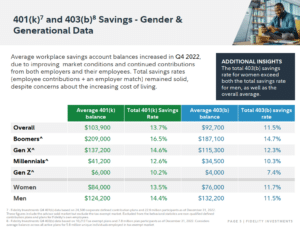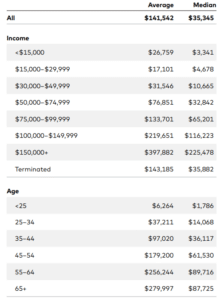A few weeks ago I shared some data on average income levels across different age groups in America. As it turns out, that post was read by quite a few more people than what I typically see.
I would guess the main reason is simply that people like to compare their finances to others. We love seeing how our situation stacks up against the average person to give us some sense of whether we’re on track or not.
So, continuing with this exercise, I recently saw some data on how much money Americans have saved in retirement accounts that I wanted to share.

There were an estimated 100 million Americans who had access to a retirement plan through their employer in 2021. However, only 51% of those people chose to contribute to their workplace plan.
Fidelity, one of the largest investment custodians in the world, released information showing the average retirement account balance is a little over $100,000:

As you can see, since wealth tends to be positively correlated with age, the average balances are higher for older generations. They’ve had more time to save and more time for their money to grow within their accounts.
The average savings rates seem pretty healthy to me, granted those numbers are including employer match contributions.
Fidelity also shared that the average IRA balance is $104,000, which is almost identical to the 401k/403b balances.
Vanguard, another large custodian that covers about 5 million retirement plans for individuals, released figures stating their average retirement plan balance is a little higher at $141,000.
They also broke down average balances by age and income level which I think is helpful and provides more context:

These numbers mirror the Fidelity data. Those who are older and have higher incomes are able to save and accumulate more money.
I do think it’s important to note that averages are often skewed by a small number of people with extremely big account balances. You can see that the “median” column numbers, which show the middle person’s balance in the sample, are much lower.
Assuming that someone has both a 401k and an IRA, you could say the average person’s combined retirement account balance would be around $200,000.
Is that enough?
Well, Bloomberg conducted a survey where they asked respondents, “How much is enough to retire comfortably?” Here were the results:

The average number came in somewhere between $3 million and $5 million.
According to DQYDJ which includes people’s primary residence in this calculation, only 4.4% of all households have a net worth of $3 million or more. And only 2.8% of households have a net worth above $5M.
There seems to be a pretty big disconnect between how much people think they’ll need to retire and how much they have saved. Everyone thinks they’ll eventually become a millionaire, but the number of people who actually pull it off is quite small.
While there is no one-size-fits-all answer, a good rule of thumb for how much net worth you’ll need to retire is anywhere from 25 to 30 times your annual spending. For example, if you want to spend $50,000 a year in retirement, you’ll likely need around $1,500,000.
Now, 401ks and IRAs usually aren’t the only places people are saving for retirement. In reality, people will have multiple retirement plans from different employers, brokerage accounts, rental properties, inheritances, and Social Security that will all factor into someone’s ability to retire.

To end, my takeaway from all of this data has really nothing to do with the numbers. My takeaway is, whatever your retirement account balance is right now, focus on what you can control. And the main thing you can control when preparing for retirement is how much you save.
If you strive to maintain a double-digit savings rate, increase your savings every so often, and invest in a balanced portfolio, you’ll be pleasantly surprised by how large that retirement account balance will grow to be over time.
Thanks for reading!

